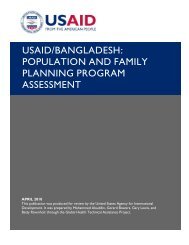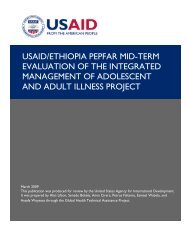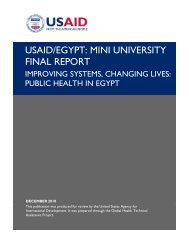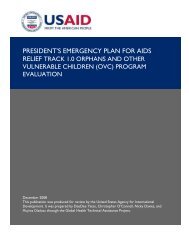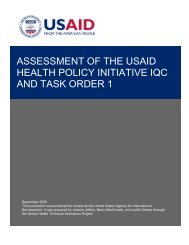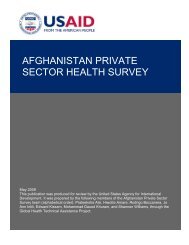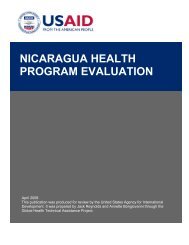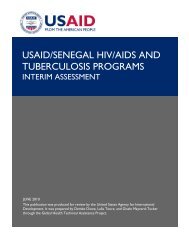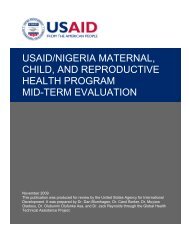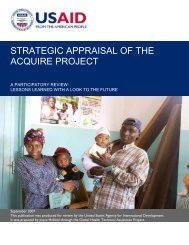Zimbabwe HIV/AIDS Partnership Project & Behaviour Change
Zimbabwe HIV/AIDS Partnership Project & Behaviour Change
Zimbabwe HIV/AIDS Partnership Project & Behaviour Change
- No tags were found...
Create successful ePaper yourself
Turn your PDF publications into a flip-book with our unique Google optimized e-Paper software.
4. CONCLUSIONSPROJECT PERFORMANCEThe <strong>Zimbabwe</strong> <strong>HIV</strong>/<strong>AIDS</strong> <strong>Partnership</strong> <strong>Project</strong> and the <strong>Behaviour</strong> <strong>Change</strong> Communication Programme display ahigh level of performance with excellent progress to date. The substantial progress is even more remarkable giventhe economic decline and political turmoil.The rate of progress for major interventions that contribute directly to <strong>HIV</strong>/<strong>AIDS</strong> mitigation nationally isimpressive (see Figure 13). At about half-way through the life of the project, achievement in most indicator andcontractual agreement areas is on or ahead of schedule. The number of persons receiving T&C services has alreadyreached nearly 70 percent of the total targeted for the end of the project, and current totals for female condomdistribution have nearly attained the entire project goal.Figure 13: Rate of Progress in Selected Key Indicators (Through July, 2008)PersonsReceiving T & CServic esElapsed Implementation Life = 45%68.5Consequently, the project should exceed many originalexpectations and will return better results than donorsanticipated. Given the high rates of achievement, it maybe useful for donors and project staff together to revisethe goals upward for high-performing interventions.IndicatorMale CondomDistributionFemale CondomDistributionSou rce: PSI/<strong>Zimbabwe</strong>54920 10 20 30 40 50 60 70 80 90 100PercentPortion oftotal targetachievedTo enhance performance, PSI/Z uses a gendersensitiveapproach to programming, as evidenced in theuse of research (such as the TRaC Surveys) that isgender-specific, especially on concurrent relationships,cross-generational sex, and sexual debut.Implementation of the BCC component, for example,is guided by clear and data-supported gender-specificindicators. This information is then incorporated withinannual programming to maximize beneficial impactwithout regard to gender.However, there is little evidence on how well the project reaches such socially excluded groups as formercommercial farm workers and displaced populations. People living with disabilities also are not targeted by thecommunication campaigns. Communication efforts for youth are more oriented on abstinence; there is limitedcontent for youth in Be Faithful campaigns or BCC related to concurrent relationships and cross-generational sex.Marketing campaigns on condom use also need to more actively reach out to adolescents—a group particularlyvulnerable to <strong>HIV</strong> infection.IMPACT OF THE PROGRAM ON THE <strong>HIV</strong>/<strong>AIDS</strong> EPIDEMICBoth the availability of and access to <strong>HIV</strong>/<strong>AIDS</strong> key services have improved. <strong>Project</strong>-supported counseling andtesting reach increasing numbers of people each year and in 2007 represented nearly half (46%) of all the personstested in <strong>Zimbabwe</strong>. About 70 percent of all male condoms distributed in the country in 2007 were a result ofproject social marketing. Male condoms are one of the few products still regularly available in many shops.NGOs are more active in service delivery as a result of the project, and their efforts have expanded outreach incommunities. Creative approaches to finding new venues for offering products and services are increasingfunctional access for a wider spectrum of the population. Good examples are workplace counseling and testing,collaboration with IOM for mobile and vulnerable populations, and using hair salons and CSW groups to distributefemale condoms.Communication activities are also reaching substantial numbers of people, particularly the condom and otherprevention campaigns, which have reached an estimated 75 percent of all adult <strong>Zimbabwe</strong>ans (see Figure 14). In<strong>Zimbabwe</strong> <strong>HIV</strong>/<strong>AIDS</strong> <strong>Partnership</strong> <strong>Project</strong> & <strong>Behaviour</strong> <strong>Change</strong> Programme: A Joint USAID/DFID Assessment 23




